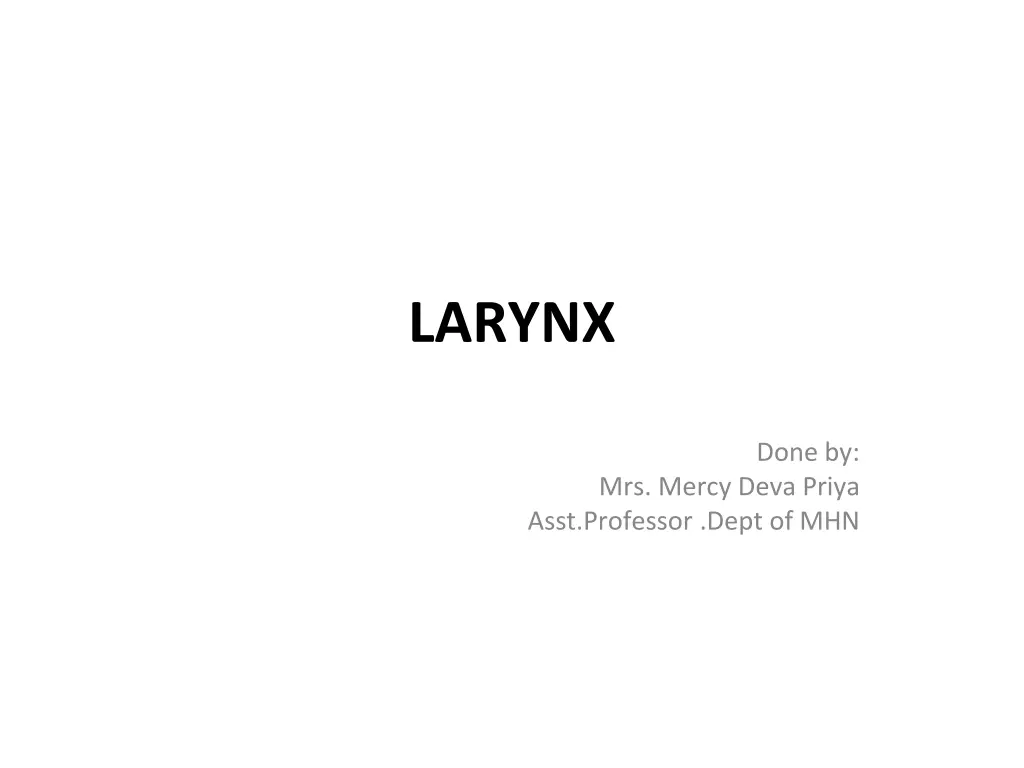
Understanding the Anatomy of the Larynx
Explore the structure and function of the larynx, also known as the voice box. Learn about its position in the body, associated structures, and the main cartilages that make up this crucial part of the respiratory system. Dive into the details of the thyroid cartilage, cricoid cartilage, and more to gain a comprehensive understanding of the larynx.
Download Presentation

Please find below an Image/Link to download the presentation.
The content on the website is provided AS IS for your information and personal use only. It may not be sold, licensed, or shared on other websites without obtaining consent from the author. If you encounter any issues during the download, it is possible that the publisher has removed the file from their server.
You are allowed to download the files provided on this website for personal or commercial use, subject to the condition that they are used lawfully. All files are the property of their respective owners.
The content on the website is provided AS IS for your information and personal use only. It may not be sold, licensed, or shared on other websites without obtaining consent from the author.
E N D
Presentation Transcript
LARYNX Done by: Mrs. Mercy Deva Priya Asst.Professor .Dept of MHN
Position The larynx or 'voice box' extends from the root of the tongue and the hyoid bone to the trachea. It lies in front of the laryngo-pharynx at the level of the 3rd, 4th, 5th and 6thcervical vertebrae. Until puberty there is little difference in the size of the larynx between the sexes. Thereafter it grows larger in the male, which explains the prominence of the 'Adam's apple' and the generally deeper voice.
Structures associated with the larynx Superiorly the hyoid bone and the root of the tongue Inferiorily it is continuous with the trachea Anteriorly the muscles attached to the hyoid bone and the muscles of the neck Posteriorly the laryngopharynx and 3rd to 6th cervical vertebrae Laterally the lobes of the thyroid gland
Structure The larynx is composed of several irregularly shaped cartilages attached to each other by ligaments and membranes. The main cartilages are: 1 thyroid cartilage 1 cricoid cartilage 2 arytenoid cartilages 1 epiglottis hyaline cartilage elastic fibrocartilage.
The thyroid cartilage This is the most prominent and consists of two flat pieces of hyaline cartilage, or laminae, fused anteriorly, forming the laryngeal prominence (Adam's apple). Immediately above the laryngeal prominence the laminae are separated, forming a V- shaped notch known as the thyroid notch.
The thyroid cartilage is incomplete posteriorly and the posterior border of each lamina is extended to form two processes called the superior and inferior cornu. The upper part of the thyroid cartilage is lined with stratified squamous epithelium like the larynx, and the lower part with ciliated columnar epithelium like the trachea. There are many muscles attached to its outer surface.
The cricoid cartilage This lies below the thyroid cartilage and is also composed of hyaline cartilage. It is shaped like a signet ring, completely encircling the larynx with the narrow part anteriorly and the broad part posteriorly. The broad posterior part articulates with the arytenoid cartilages above and with the inferior cornu of the thyroid cartilage below.
The arytenoid cartilages. These are two roughly pyramid- shaped hyaline cartilages situated on top of the broad part of the cricoid cartilage forming part of the posterior wall of the larynx. They give attachment to the vocal cords and to muscles and are lined with ciliated columnar epithelium.
The epiglottis. This is a leaf-shaped fibroelastic cartilage attached to the inner surface of the anterior wall of the thyroid cartilage immediately below the thyroid notch. It rises obliquely upwards behind the tongue and the body of the hyoid bone. It is covered with epithelium. If the larynx is likened to a box then the epiglottis acts as the lid; it closes off the larynx during swallowing, protecting the lungs from accidental inhalation of foreign objects. stratified squamous
Blood and nerve supply Blood is supplied to the larynx by the superior and inferior laryngeal arteries and drained by the thyroid veins, which join the internal jugular vein. The parasympathetic nerve supply is from the superior laryngeal and recurrent laryngeal nerves, which are branches of the vagus nerves.
Interior of the larynx The vocal cords are two pale folds of mucous membrane with cord-like free edges which extend from the inner wall of the thyroid prominence anteriorly to the arytenoid cartilages posteriorly.
Functions Production of sound. Speech. Protection of the lower respiratory tract Passageway for air. Humidifying, filtering and warming.
Interior of the larynx viewed from above. The extreme positions of the vocal cords.
